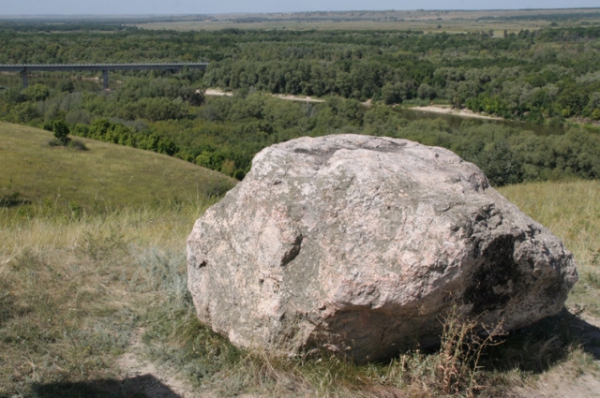Tags are not available

The Aleksandrovskiy graben is a geological cross-section of the tectonic structure located on the right bank of the Volga River between the villages of Gornaya Proleika and Gorniy Balykley. The graben was named after the Сossac village, located here, called Aleksandrovskaya, now the village of Suvodskaya.

At the large Volgograd region between two rivers, the Volga River and the Akhtuba River, there is a really wonderful valley named the Volga-Akhtuba Floodplain (Volgo-Akhtubinskaya Poyma). The natural park of the Volga-Akhtuba Floodplain (Prirodniy park Volgo-Akhtubinskaya Poyma) covers two regions of Astrakhan and Volgograd and also a part of the Republic of Kalmykiya.

Small bitter salty lake Bulukhta is situated dozens kilometres west of lake Elton. The name of the lake “Bulukhta” can be translated from Kalmyk as a “spring” lake. The water line is not very high there, however some areas of the lake are boggy, but in spite of this, lake Bulukhta is a perfect place to enjoy the unique nature of the Volga region steppes in its undisturbed state.

The Kamyshinskie Ushi (ears) Mountains are located in the nature reserve not far from the town of Kamyshin. These are old small mountains (30-40 meters high) comprised of the large grey sandstone slabs. The slab bases are covered with pieces of ancient tree leaf prints.

In Ilovlinskiy district of the Volgograd region, on the territory of the Donskoy Nature Park the chalk mountain with the name “Krasnaya” (red) is situated. The locals call it “Mare’s head” (rus. Kobyliya golova) as the mountain resembles the head of a horse.

Nizhnehopyersky Natural Park attracts its guests by amazing geological formations – Ice boulders (rus. Valun).
These huge ice granite stones in 2-3 meters height were left after ice melting. Such boulders cover Kalach hill especially the right bank of the Hopyer River. The largest stone (2 meters height and 3 meters in diameter) is located on the downhill of the Hopyer Valley, near Slashchevsky Village after which it was named – Slashchevsky boulder stone.

The Medveditskaya Gryada ridge is one of the most amazing places in the Volgograd region. It is a chain of low 200-380 metres high hills located in the north-eastern part of the Volgograd region not far from the town of Zhirnovsk.

Lake Elton is situated in Pallasovskiy District of the Volgograd region. Elton Nature Park is named after the lake as well as Elton settlement, located 5 kilometres from it. It is the largest salt lake in Europe of 152 km². Elton is called a pearl of the Volga steppes or the second Dead Sea.

Olga's spring is placed in Zhirnovsky district at the border with the Saratov region near the Vishnevoe rural settlement. The history of the spring’s origin is unknown, but the locals have always looked after the source of clean water. The healing properties of the spring have been known since ancient times.

The Sarpinskiy Island, located on the Volga river opposite Volgograd, is the biggest river island in Europe, which is 20 kilometres long and 18 kilometres wide. The nature reserve is more than 11 square hectares. The Island’s eastern coast is washed by the Volozhka river, formerly called Sarpa, where the name of the island took its origin.

The Donskoy Nature Park is located at the joint of steppe zone and semi-dessert. The park features unique picturesque landscape where chalk mountains adjoin steppes, meadows, and forests.

The Nizhnehoperskiy Nature Park was granted its status in 2003 because of its unique nature and original Cossack ethnos. The park covers a total area of about 230,000 hectares and occupies the territory of three administrative districts of the Volgograd region – Kumylzhenskiy, Alekseevskiy and Nekhaevskiy.

The Khoper River rises in the central part of the Penza region and joins the Don River in the Volgograd region. There are wildlife reserves with rich flora and fauna in the river valley. Here you can admire beautiful landscapes and visit wonderful places.

On the territory of the Maksim Gorkiy settlement, at the source of the Tsaritsa river there is Taran’s spring well known for its healing properties. Before the revolution of 1917, the landowner of the settlement was Nikolai Taranov. Later the settlement was named after Maxim Gorkiy and now is popularly known as Maksimka.
After the dispossession in 1930, Nikolai Taranov, called by the locals “old Taran”, settled down near the spring and took care for it his whole life.

The hydrosulfuric spring was accidentally discovered in Ilovlinskiy district of the Volgograd region between the settlements of Kachalino and Krasnodonskiy during the exploration more than half a century ago. A 2-meter high water jet with bitter taste welled out of surface. The spring became popular among the locals because of its healing properties.

The Shherbakovskaya gully is associated with the Swiss Alps foothills by its splendor. Unique climate and landscape are favourable for rare plants and wild animals. Here, you can see scorpions, wild boars, moos, deer and roe deer.

The Shcherbakovskiy Nature Park is located in Kamyshinskiy district of Volgograd region along the Volga River. The park occupies 34,570 square hectares. Diverse natural zones are represented in the park: steppes, forest steppes and semi-deserts with rich local fauna and flora.

A beautiful place is located not far from the Shcherbakovskaya ravine where 10 giant columns of 90-100 meters stand along the bank of the Volga reservoir and attract visitors. These columns are called Stolbichi and look like a strong defensive wall with towers.